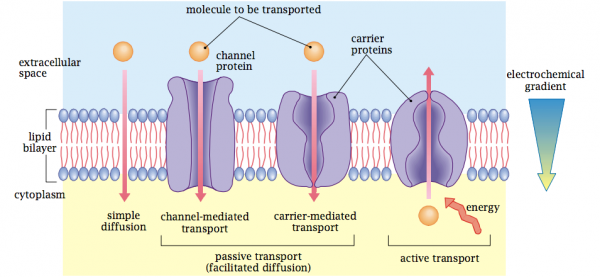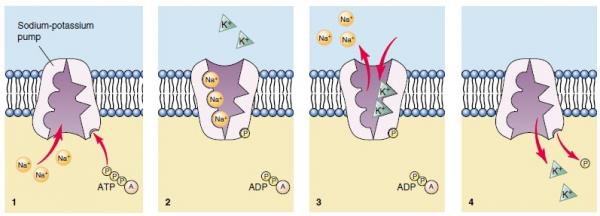Nutrient Transportation, Sodium Pump Style
Since everyone seems to be spraying something, let's do some Plant Physiology and look at how nutrients get into the plant. Be it root or leaf, at the cellular level, nutrients applied have to enter in. This may affect how you think about and how you build your fertility-oriented sprays.
There are 4 recognized mechanisms for movement of nutrients through cell membranes:
-
[*]Diffusion. There's this thing called the Lipid Bilayer. Basically a cellular sandwich and simply, if a nutrient can soak it's way through both layers of bread, butter, turkey and mayo, that's diffusion.
[*]Ion Channel. Like Diffusion, doesn't require energy. A single ion is selected and passes through the ropes like a hot chick into a club.
[*]Protein Channel. Nutrient passes via being grabbed by a protein structure as if being a member at the Moose Lodge.
[*]Active Transport. Requires energy to move a nutrient often from lower concentrations to higher (the other methods rely on high to low concentration movement).

All plant nutrients (except Boron, which needs a molecular staff) enter into cells all alone in their ionic form. So one way or another, be it passive/concentration oriented (rare) or active/energy transport (common)... this is the deal. A charged ion with either negative or positive property will distribute itself based on finding opposite charges and heading that way. It's electrostatic. What this really means is that there are positive and negative charges at play and when they move, they create voltage which in turn helps drive the transport system. Bigger magnets can hold more stuff on the fridge. Pretty simple. And we can measure this Potential Distribution (PD) and use it to predict what happens as ions cross back and forth from the club to the Starbucks to the crack dealer and back and forth.
Really, it's pretty easy. Positive- and negative-charged ions are all battling for seats at the bar and there's only so many bar seats, so the process of looking around for those seats creates a buzz.
There's this cool equation called The Nernst Equation which basically says that this can call be predicted based on a bunch of factors to know when the gradient of concentration (passive) and the electrical concentration (energy required) will reach equilibrium. And so when the opposing gang members all want the seats in the club, this equation can sort of predict what is going to happen so we can radio the bouncers.
You may have heard about this thing called the sodium-potassium pump. For turfheads, getting how this works on the cellular level makes for a great understanding of why potassium is more than just a plant food nutrient, but rather a required physiological garbage hauler.
Active Transport is responsible for cells containing relatively high concentrations of Potassium ions but low concentrations of Sodium ions. The mechanism responsible for this is the sodium-potassium pump, which moves these two ions in opposite directions across the plasma membrane. Kind of like someone has to leave the bar and enter the bar at the same time, or the universe will crumble. This was all figured out by following the passage of radioactively labeled ions across the plasma membrane of certain cells.
It was found that the concentrations of sodium and potassium ions on the two sides of the membrane are interdependent, suggesting that the same carrier transports both ions. It is now known that the carrier (read: club bouncer) pumps three sodium ions out of the cell for every two potassium ions pumped in. So when I don't have enough K+ ions at the door, and a lot of Na+ in the club, problems.
Export of sodium from the cell provides the driving force for several membrane transport proteins, which import glucose, amino acids (building blocks for more good proteins) and other nutrients into the cell by use of the sodium gradient.

So for me, when someone has concocted the latest and greatest fertility product by discovering "amazing new uptake technology", I'm an immediate skeptic, because even though I make club/ropes/chicks and bouncer analogies, it's complicated stuff. The sodium-potassium pump was discovered in the 1950s by a Danish scientist named Skou, who was awarded a Nobel Prize in 1997. It marked an important step forward in our understanding of how ions get into and out of cells.
The energy that is driving this comes from a thing called ATP-ace. The ATP stands for Adenosine triphosphate. And in case you never heard or forgot, ATP is the thing that stores energy from the light reaction that happens during photosynthesis.
We are talking about the cellular level here. And when you are being told what you need or don't need, looking at what that nutrient can or won't do is huge. If I need that sodium-potassium pump working and there is no potassium, then I've failed to use the Nernst Equation to realize that I've probably just increased the voltage that in turn increases the wilt potential in my cells. Bad.
Hang on tight. Next blog, I'm going to look at ion concentrations and distribution in the plant.



4 Comments
Recommended Comments